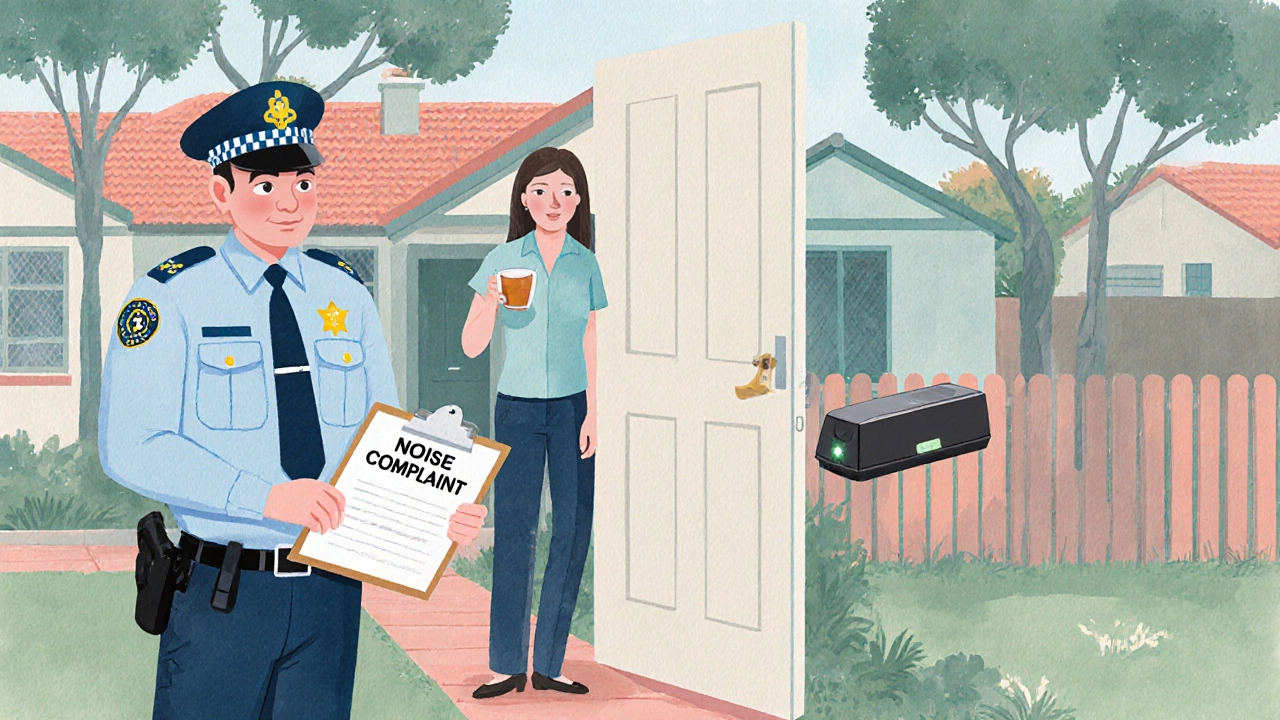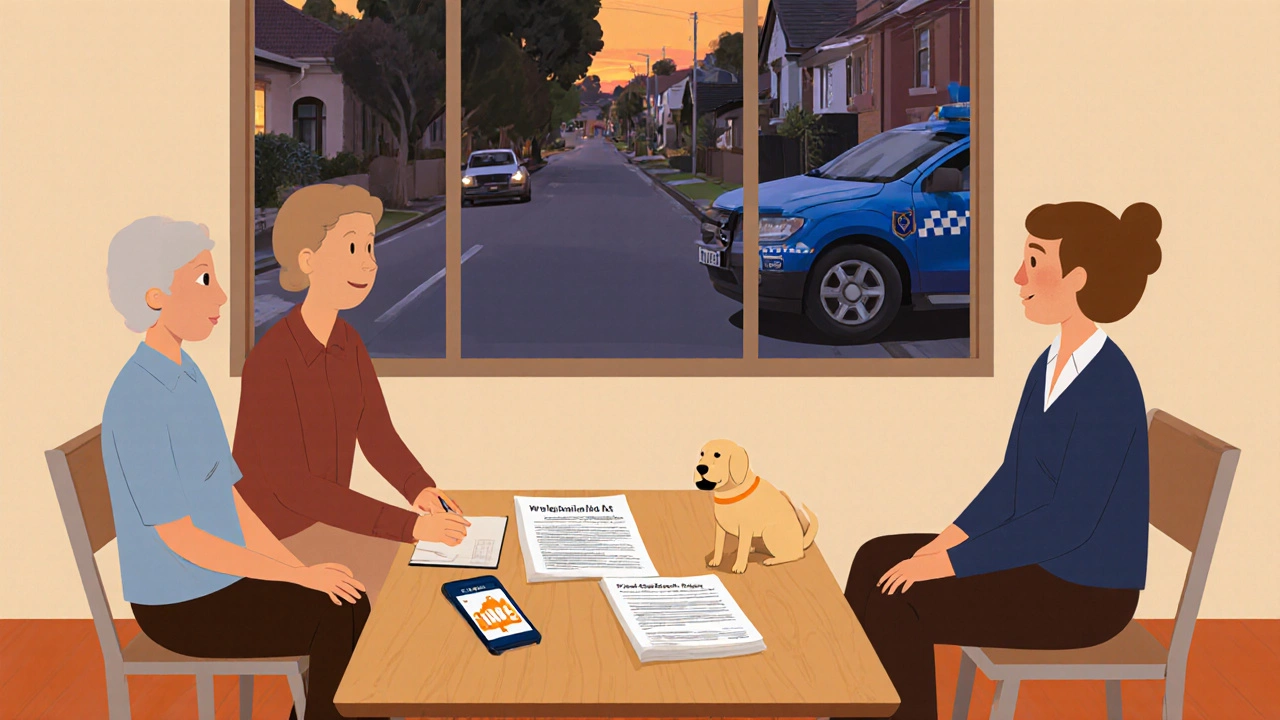Imagine you’re trying to finish a work‑from‑home project when the Neighbour's Barking Dog is nonstop, echoing down the hallway and breaking your concentration. You’ve asked politely, you’ve left a note, but the sound keeps coming. Should you dial barking dog police on a whim, or are there smarter steps you can take first? This guide walks you through the legal landscape in Adelaide, the realistic role of the police, and practical alternatives-like pet‑friendly alarms-that keep the peace without a 000 call.
What the law actually says about noisy pets in South Australia
South Australia’s Domestic Animal Act 1994 gives councils the power to regulate nuisance animals. Most local government areas, including the City of Adelaide, have a Noise and Nuisance By‑law that defines “excessive noise” as any sound that unreasonably interferes with the comfort of neighbours for more than 30 minutes a day, on average, over a 7‑day period. A constantly howling dog can meet that definition, especially during the statutory "quiet hours" (usually 10 pm‑7 am).
The Act does not give the South Australian Police a direct mandate to intervene in pet‑noise disputes. Their primary role is to respond to criminal offences or breaches of public order. When a neighbour’s dog is merely noisy, the police may advise you to contact the relevant animal control agency or council instead of issuing a formal warning.
When the police can actually help
There are three scenarios where a call to the police is justified:
- Threat of violence - If the dog is aggressive, bites, or the owner threatens you, that becomes a criminal matter.
- Public safety - A dog running loose at night, creating a traffic hazard, can be reported.
- Escalated disturbance - If the noise has already escalated to a breach of a court‑issued injunction, the police can enforce the order.
In all other cases, the police will likely refer you to an Animal Control Officer or the local council’s by‑law enforcement team.
Alternative routes before picking up the phone
Most neighbours want a good relationship, so a step‑by‑step approach often resolves the issue without official involvement.
- Document the disturbance. Keep a log of dates, times, and duration. Short audio clips (captured on a smartphone) can be useful if you later need to prove a pattern.
- Communicate directly. A friendly knock or a written note referencing the specific by‑law can make the owner aware that the problem is documented.
- Offer a solution. Suggest a Pet Friendly Alarm that triggers a gentle vibration or light when the dog barks, encouraging the owner to train the pet without distress.
- Contact the local council. Many councils provide a free “noise complaint” form that triggers a formal written warning to the dog owner.
- Seek mediation. Mediation Services specialised in neighbor disputes can negotiate a mutually agreeable schedule for dog walks or indoor quiet zones.
These steps not only preserve goodwill but also build a stronger case if you eventually need to involve authorities.

How to make a proper noise complaint
Should you decide that the problem warrants official action, follow this checklist to make the process as smooth as possible:
- Gather evidence: timestamps, recordings, and your disturbance log.
- Identify the correct agency: In Adelaide, the City of Adelaide’s By‑law Enforcement Team handles pet noise. The police non‑emergency number (131 444) is for threats or safety concerns.
- Submit a written complaint: Include your evidence and reference the Domestic Animal Act 1994 and the relevant council by‑law section.
- Request a response timeline: Councils usually respond within 14 days. Ask for a written acknowledgment.
- Follow up: If the noise continues after the council’s warning, you can request an on‑site inspection or, as a last resort, involve the police.
Quick comparison: Police, Council, Animal Control, Mediation
| Authority | Primary Power | Typical Response Time | Best Use Case |
|---|---|---|---|
| South Australian Police | Enforce criminal law & public safety orders | Immediate (emergency) or same‑day for non‑emergency 131 444 | Aggressive dog, threats, or breach of court injunction |
| Local Council | Apply by‑law noise limits under the Domestic Animal Act | 5‑14 days for written warning, up to 30 days for inspection | Pure nuisance - repeated barking during quiet hours |
| Animal Control Officer | Issue compliance notices, seize animals in extreme cases | Within 7 days of referral | When the dog’s behaviour threatens animal welfare or public health |
| Mediation Services | Facilitate voluntary agreements between parties | Usually 1‑2 weeks to schedule a session | When you want a long‑term neighborly solution without legal penalties |

Checklist: De‑escalating a barking‑dog issue
- Record date, time, and length of each barking episode.
- Try a friendly knock; reference the council’s noise by‑law.
- Suggest a Pet Friendly Alarm that alerts the owner without startling the dog.
- Submit a council noise complaint with evidence.
- If no improvement after council warning, contact a Mediation Service for a facilitated discussion.
- Only involve the South Australian Police when safety or criminal concerns arise.
Frequently Asked Questions
Can I call 000 for a barking dog?
Only if the dog is posing an immediate safety risk, such as attacking people or causing a traffic hazard. For pure noise, 000 is not appropriate; use the non‑emergency 131 444 or the council’s noise line.
What evidence do I need for a council complaint?
A simple log of dates and times, a short audio clip, and any written communication with the neighbour. The council may ask for a copy of the log when they issue a warning.
Will the police fine my neighbour for a noisy dog?
Usually not. The police can issue a warning, but fines for pet‑noise are normally administered by the council under the local by‑law.
Are there any tech solutions that help?
Yes - Pet Friendly Alarms (e.g., ultrasonic bark detectors) can alert owners privately, prompting quicker training without distressing the animal.
What if my neighbour refuses to cooperate after a council warning?
You can request a compliance inspection. If the dog still breaches the by‑law, the council may issue a fine or, in extreme cases, involve animal control to enforce a training order.

